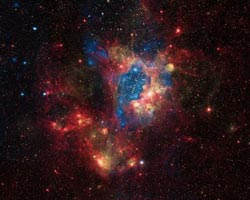A Surprisingly Bright Superbubble

X-ray: NASA/CXC/U.Mich./S.Oey, IR: NASA/JPL, Optical: ESO/WFI/2.2-m<br> <br>The star cluster NGC 1929 contains massive stars that produce intense radiation, expel matter at high speeds, and race through their evolution to explode as supernovas. The winds and shock waves carve out huge cavities called superbubbles in the surrounding gas. X-rays from Chandra (blue) in this composite image reveal the regions created by these winds and shocks, while infrared data from Spitzer (red) outline where the dust and cooler gas are found. Optical light from an ESO telescope in Chile (yellow) shows where ultraviolet radiation from the young stars is causing the gas to glow.<br>
Many new stars, some of them very massive, are forming in the star cluster NGC 1929, which is embedded in the nebula N44, so named because it is the 44th nebula in a catalog of such objects in the Magellanic Clouds. The massive stars produce intense radiation, expel matter at high speeds, and race through their evolution to explode as supernovas.
The winds and supernova shock waves carve out huge cavities called superbubbles in the surrounding gas. X-rays from NASA's Chandra X-ray Observatory (blue) show hot regions created by these winds and shocks, while infrared data from NASA's Spitzer Space Telescope (red) outline where the dust and cooler gas are found. The optical light from the 2.2-m Max-Planck-ESO telescope (yellow) in Chile shows where ultraviolet radiation from hot, young stars is causing gas in the nebula to glow.
A long-running problem in high-energy astrophysics has been that some superbubbles in the LMC, including N44, give off a lot more X-rays than expected from models of their structure. These models assume that hot, X-ray emitting gas has been produced by winds from massive stars and the remains of several supernovas. A Chandra study published in 2011 showed that there are two extra sources of N44’s X-ray emission not included in these models: supernova shock waves striking the walls of the cavities, and hot material evaporating from the cavity walls.
The Chandra observations also show no evidence for an enhancement of elements heavier than hydrogen and helium in the cavities, thus ruling out this possibility as a third explanation for the bright X-ray emission. Only with long observations making full use of the capabilities of Chandra has it now become possible to distinguish between different sources of the X-rays produced by superbubbles.
The Chandra study of N44 and another superbubble in the LMC was led by Anne Jaskot from the University of Michigan in Ann Arbor. The co-authors were Dave Strickland from Johns Hopkins University in Baltimore, MD, Sally Oey from University of Michigan, You-Hua Chu from University of Illinois and Guillermo Garcia-Segura from Instituto de Astronomia-UNAM in Ensenada, Mexico.
NASA's Marshall Space Flight Center in Huntsville, Ala., manages the Chandra program for NASA's Science Mission Directorate in Washington. The Smithsonian Astrophysical Observatory controls Chandra's science and flight operations from Cambridge, Mass.
Media Contact
More Information:
http://www.harvard.eduAll latest news from the category: Physics and Astronomy
This area deals with the fundamental laws and building blocks of nature and how they interact, the properties and the behavior of matter, and research into space and time and their structures.
innovations-report provides in-depth reports and articles on subjects such as astrophysics, laser technologies, nuclear, quantum, particle and solid-state physics, nanotechnologies, planetary research and findings (Mars, Venus) and developments related to the Hubble Telescope.
Newest articles

“Nanostitches” enable lighter and tougher composite materials
In research that may lead to next-generation airplanes and spacecraft, MIT engineers used carbon nanotubes to prevent cracking in multilayered composites. To save on fuel and reduce aircraft emissions, engineers…

Trash to treasure
Researchers turn metal waste into catalyst for hydrogen. Scientists have found a way to transform metal waste into a highly efficient catalyst to make hydrogen from water, a discovery that…

Real-time detection of infectious disease viruses
… by searching for molecular fingerprinting. A research team consisting of Professor Kyoung-Duck Park and Taeyoung Moon and Huitae Joo, PhD candidates, from the Department of Physics at Pohang University…





















